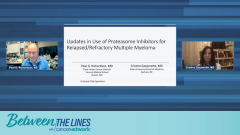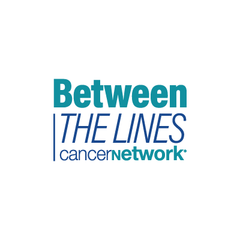
Proteasome Inhibition in MM: In-Class Transition From Bortezomib to Ixazomib
Experts Paul Richardson, MD, and Cristina Gasparetto, MD, discuss trial data analyzing the in-class transition from bortezomib to ixazomib for patients with multiple myeloma.
Episodes in this series

Transcript:
Paul G. Richardson, MD: We can think a little about how we use proteasome inhibition in the context of real-world practice. This is a particularly nice study because it’s a real-world practice paper from our colleagues, with the senior author Robert Rifkin and his team presenting nice data on the feasibility of long-term proteasome inhibition and translating by in-class transition from bortezomib to ixazomib.
As you can see in this treatment plan, or protocol, as the team put it together, this involved 160 newly diagnosed patients. After induction-remission therapy with bortezomib-based treatment, they went on to ixazomib, lenalidomide, and dexamethasone. The use of ixazomib was classically in the IRd [ixazomib, lenalidomide, dexamethasone] schedule, with adjustments for steroid according to age. If you look at the response rates and best overall responses, what’s particularly interesting is that this algorithm of real-world transition of continuity and tolerability of therapy translates into improved high-quality responses over time. I’m particularly struck in this study by the fact that the VGPR [very good partial response] or CR [complete response] rate in this real-world experience is quite nice. It’s solid, and you see it improve over time. The overall response rate is very respectable, but the VGPR rate or better is a solid 55%, and about half those patients, 26%, achieve complete remission. It’s quite interesting. Christina, what do you think of this?
Cristina Gasparetto, MD: This was a very interesting study. It was targeting patients with myeloma in the community who are ineligible for clinical trials. Their criteria weren’t so stringent. In fact, 44% of the patients were over the age of 75, so they were enrolling the older population coming with the baggage of comorbidities and other issues, meaning more frail performance status. They were targeting patients we don’t necessarily target in a clinical trial for different reasons. There were a fair amount of patients with compromised renal [function], so patients with other malignancies were excluded from clinical trials.
These patients are now eligible for clinical trial, so can we expose them to a long-term proteasome inhibitor? Can this patient sustain therapy for a prolonged period of time? I don’t know, but this won’t be my first choice for the newly diagnosed patients, but I’m glad that we have these options available for some patients. I was intrigued by the durability and that the patients were able to sustain therapy longer. As you mentioned, the depth of response was improving with time and without affecting the quality of life. They were able to sustain therapy for a prolonged period of time. At the beginning, this was not my first choice, but this is a very good choice for a population of patients with myeloma with other issues that will now be able to sustain a more aggressive therapy. I’m pleasantly surprised.
Paul G. Richardson, MD: I agree, and that’s what’s so interesting to me about these data: the construct that you can seamlessly transition from bortezomib as a parenteral approach to an oral approach that continues to improve response over time. It’s very nice to have prospective data to share with the patients. You can actually say, “We have real-world information from a well-conducted protocol,” recognizing all the caveats, with proof nonetheless that you can improve response nicely over time. The tolerability profile is particularly encouraging, but what caught my attention was that tincture of time really matters. This is 84 patients strong. Your initial complete response rate after 3 cycles is 4%, but if you’re patient and you focus on tolerability—this continuity of treatment, recognizing that you have to give this time—then you see that CR rate magnified to 26% with an additional 29% getting VGPR.
Cristina Gasparetto, MD: Yes, it’s not bad.
Paul G. Richardson, MD: Strategically, I like this, Christina. You’ve used boronic peptides early. You’ve used immunomodulatory therapy. But when relapse occurs, you’ve got multiple options available.
Transcript edited for clarity.
Newsletter
Stay up to date on recent advances in the multidisciplinary approach to cancer.




















































































